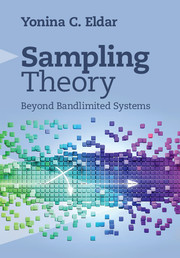Book contents
- Frontmatter
- Dedication
- Contents
- Preface
- 1 Introduction
- 2 Introduction to linear algebra
- 3 Fourier analysis
- 4 Signal spaces
- 5 Shift-invariant spaces
- 6 Subspace priors
- 7 Smoothness priors
- 8 Nonlinear sampling
- 9 Resampling
- 10 Union of subspaces
- 11 Compressed sensing
- 12 Sampling over finite unions
- 13 Sampling over shift-invariant unions
- 14 Multiband sampling
- 15 Finite rate of innovation sampling
- Appendix A Finite linear algebra
- Appendix B Stochastic signals
- References
- Index
8 - Nonlinear sampling
Published online by Cambridge University Press: 05 August 2014
- Frontmatter
- Dedication
- Contents
- Preface
- 1 Introduction
- 2 Introduction to linear algebra
- 3 Fourier analysis
- 4 Signal spaces
- 5 Shift-invariant spaces
- 6 Subspace priors
- 7 Smoothness priors
- 8 Nonlinear sampling
- 9 Resampling
- 10 Union of subspaces
- 11 Compressed sensing
- 12 Sampling over finite unions
- 13 Sampling over shift-invariant unions
- 14 Multiband sampling
- 15 Finite rate of innovation sampling
- Appendix A Finite linear algebra
- Appendix B Stochastic signals
- References
- Index
Summary
In this chapter we depart from the linear sampling model treated until now and consider recovering signals that lie in a subspace, from their nonlinear samples. Surprisingly, we will see that many types of nonlinearities that are encountered in practice can be completely compensated for without having to increase the sampling rate. Thus, even though typically nonlinearities result in bandwidth expansion, using the algorithms discussed in this chapter we will be able to recover an input from its nonlinear samples at the rate associated with the input space.
Nonlinearities appear in a variety of setups and applications of digital signal processing, including power electronics and wireless communications where an amplifier introduces nonlinear distortions to its input signal, radiometric photography, and charge coupled device (CCD) image sensors. For example, in radiometric photography, the radiometric response M(x) of a camera relates the radiance x at the input of a sensor to intensity y = M(x) at its output. This mapping is monotonically increasing (which also means that it is invertible), but may exhibit nonlinearity. The intensity signal is sampled by an ADC, and the radiance then needs to be estimated from the samples. Similar nonlinear distortions of amplitude occur in many CCD image sensors, owing to excessive light intensity which causes saturation. More generally, amplifier saturation introduces nonlinear distortion to the input signal, and occurs in many applications such as satellite communications, and power amplifiers in hand-held devices.
- Type
- Chapter
- Information
- Sampling TheoryBeyond Bandlimited Systems, pp. 283 - 322Publisher: Cambridge University PressPrint publication year: 2015

